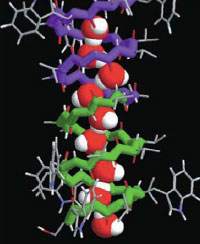| Posted: June 15, 2010 |
Nano design, just like in nature |
|
(Nanowerk News) Every living cell in our body can do it: covered with a thin membrane known as a cell membrane or nanomembrane, the cells can deliberately let specific substances in and out. Although it is thousands of times thinner than a human hair, this nanomembrane has an extremely complex structure and function. Three Nobel prizes have already been awarded for improving our understanding of these nanomembranes.
|
|
Microscopic ducts convey water, electrical charges and nutrients around and in doing so, create an equilibrium within the cell. However, we still do not know about many of the functions and structural details, as it is only the water and proton exchange that has been researched in depth. "These extremely fine cell membrane ducts, with the ability to selectively convey protons, function in exactly the same way as fuel cells created by humans", explains Dr Werner Brenner, "only this naturally occurring process is considerably more efficient".
|
 |
| MultiPlat: Proton transport similar to biological structures (Gramicidin-A).
|
|
Fuel cells: an alternative to oil
|
|
Today, fuel cells are seen as a serious alternative to oil, which until now has been the basis for electrical energy and mobility. However, the earth's oil reserves are rapidly running out, under economic pressure to drill ever deeper into the seabed. Oil combustion also generates CO2, soot and other residues. The only waste product from a fuel cell is water.
|
|
The EU project MultiPlat focuses on the design of the main component of every fuel cell - i.e. the membrane - with the intention of conveying protons more efficiently than in previous solutions. "The first results have been encouraging. It will not be easy, but it is possible. Nature has been producing these structures for billions of years and their effectiveness can be seen in every living organism. Our task is to transfer the structure of these natural nanoducts to an artificial nanomembrane, which is itself only a few hundred nanometres thick", explains Dr Jovan Matovic.
|
|
A wide range of scientific approaches are required for this project, ranging from solid state physics and nanotechnology through to chemistry. Therefore, international cooperation with six universities, research institutes and businesses is also of great importance. The EU project is being coordinated by the TU Vienna research team of Assist Prof Dr Werner Brenner, Dr Jovan Matovic and Dr Nadja Adamovic at the Institute of Sensor and Actuator Systems.
|
|
The University research team is confident: "The results of this project should have far-reaching significance for our society. If we succeed in creating the nanoducts exactly as planned, then completely different fields of application will open up, such as the accurately controlled delivery of medicine, water desalination or even new types of sensors", explains Dr Nadja Adamovic, "In this project, the boundaries between "artificial and "natural" are becoming even more blurred".
|

